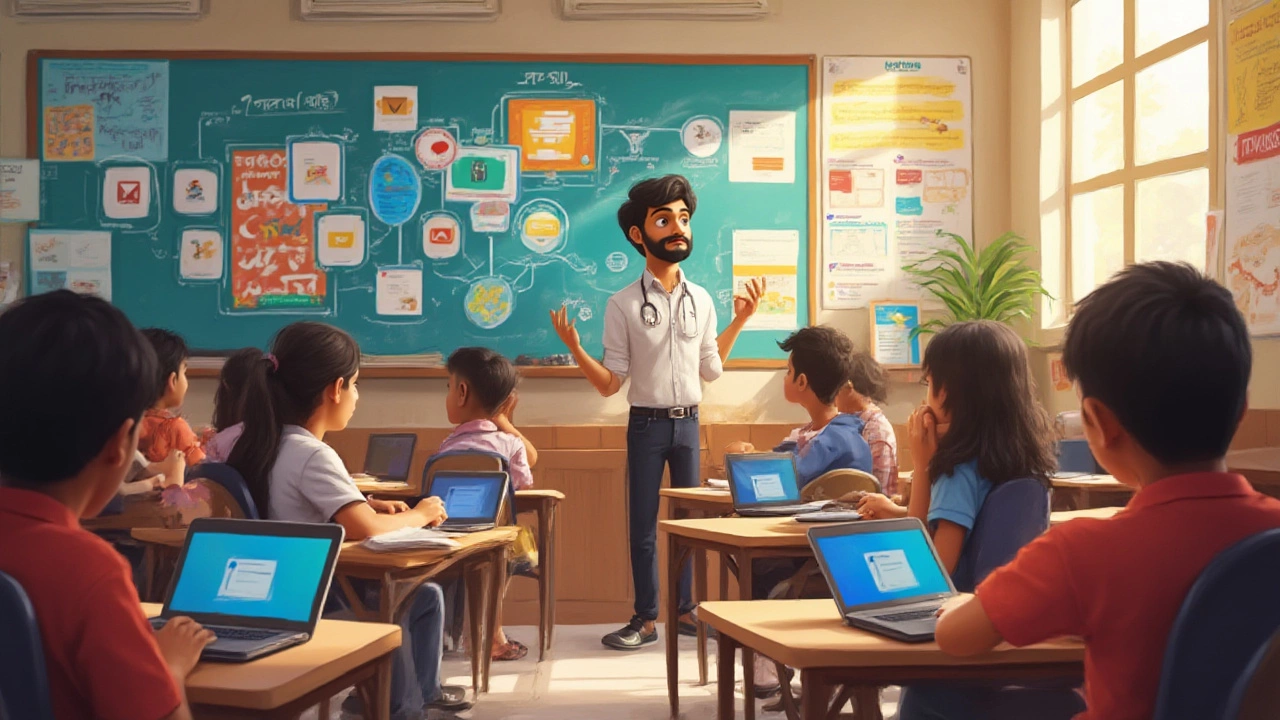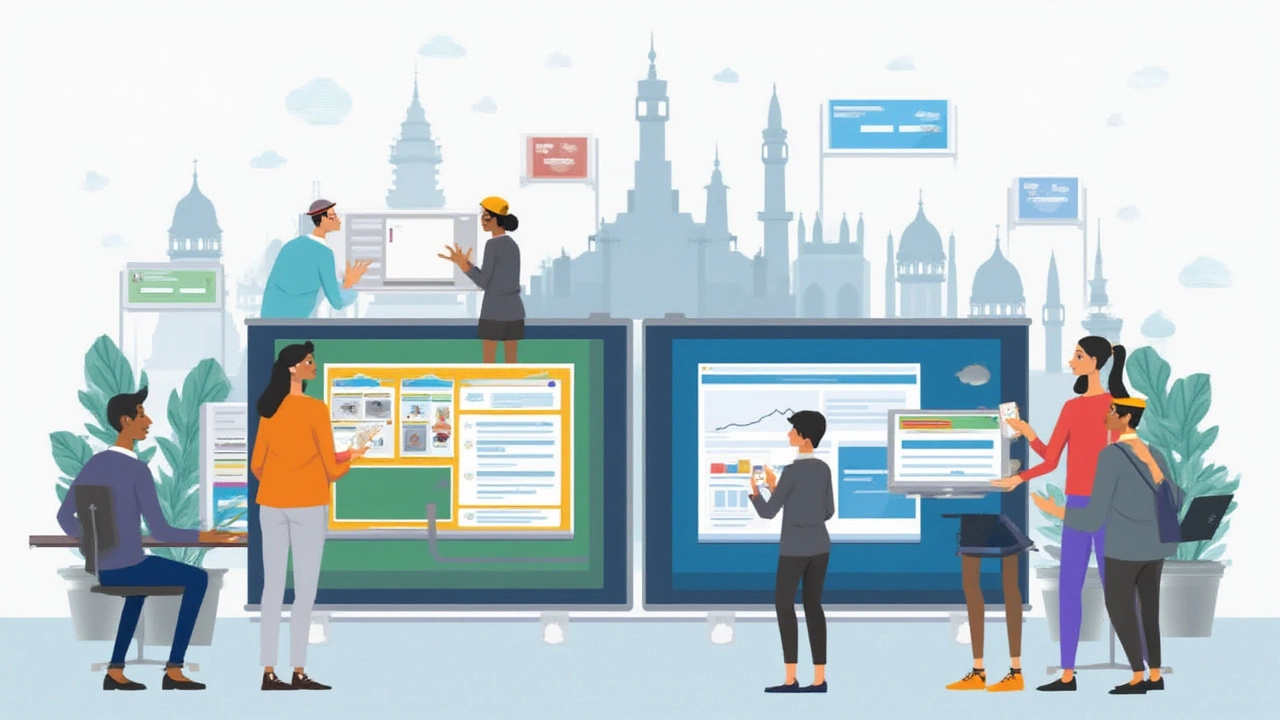Is Google Classroom a True LMS? What Educators Really Need to Know in 2025
 Jul, 26 2025
Jul, 26 2025
Picture this: every kid in your school shows up with a Chromebook, your teachers breathe a sigh of relief when assignments don’t drown in a sea of papers, and your IT person gets to actually take a lunch break. Google Classroom has crept into schools everywhere, from kindergartens to college lecture halls. Some say it’s a lifesaver, others say it’s just a fancy folder for student work. Still, a recurring debate never seems to go away: is Google Classroom really an LMS, or is it just playing dress-up as one? The answer isn’t as clear as it should be—and a lot depends on what you want from a learning management system.
What Makes an LMS, Anyway?
Let’s get the basics straight. LMS stands for Learning Management System. In plain language, that means a software platform designed to organize, deliver, track, and assess educational content and experiences. If you can deliver lessons, collect homework, grade stuff, run quizzes, keep records, and manage communication—all in one place—you’re looking at the heart of a classic LMS. Think of big players like Moodle, Canvas, or Blackboard. They have dashboards, modules, analytics, and sometimes a virtual gold star or two.
But here’s the twist: not all institutions need every bell and whistle. Some teachers just want to assign stuff and give feedback. Others demand deep analytics, automatic grading, advanced integrations, and serious content management tools. That’s where the differences start to show. Google Classroom comes from a Silicon Valley mindset—light and fast, zero clutter, and deeply connected with Google Workspace (like Google Drive and Gmail). But is that enough to check all the boxes of a ‘true’ LMS? Most experts (and frustrated teachers) find themselves in a gray zone.
Google Classroom Unpacked: What’s Under the Hood?
Let’s cut through the marketing talk and lay out what Google Classroom actually does. First up, it’s totally cloud-based. You don’t need installed software, fancy hardware, or endless IT headaches. It connects to Google Drive faster than my dog Luna sniffs out a snack. With Classroom, you can:
- Post assignments, quizzes, and questions easily
- Accept submissions in pretty much any file format
- Provide real-time feedback and comments
- Use built-in grading tools tied right into a digital gradebook
- Organize students into classes and groups (yes, sectioning is super easy)
- Send announcements and emails with a few clicks
- Schedule posts and set deadlines that integrate seamlessly with Google Calendar
- Integrate Google Meet for live sessions (especially handy post-pandemic)
- Attach rubrics, reuse assignments, and pull in templates on the fly
On top of that, everything links to your Google Drive, making file management a breeze—no more lost docs or excuses about assignments “not uploading.”
But, there’s stuff you won’t find: detailed analytics, customizable course structures, automatic prerequisite unlocking, detailed progress tracking across many courses, or a built-in content marketplace like some LMS platforms offer. Google Classroom keeps things lean. If you want advanced features—like competency-based assignments, custom reporting, or parent portals tied into every grade—prepare for some workarounds or outside tools.

How Does Google Classroom Stack Up to Traditional LMS Platforms?
It’s time for a side-by-side comparison. Here’s a real look at how Google Classroom measures up against classic, heavyweight LMS platforms:
| Feature | Google Classroom | Moodle/Canvas/Blackboard |
|---|---|---|
| Assignment Deployment | Easy, integrated with Google Drive | Advanced, highly customizable |
| Gradebook | Simple, basic analytics | Detailed, custom grading rubrics & analytics |
| Quizzes/Assessments | Google Forms integration, basic | Robust question types, adaptive, timed |
| Communication | Email, announcements, comments | Forums, messaging, announcements |
| Reporting/Analytics | Minimal, basic progress tracking | Advanced, exportable, filters galore |
| Course Structure | Linear, topic or weekly | Modules, prerequisites, mastery paths |
| Integrations/Add-ons | Limited to Google Workspace & select apps | Hundreds of integrations, open APIs |
| Mobile Experience | Great, super lightweight, app available | Good, but varies by LMS |
| Cost | Free for schools, no surprise fees | Varies: open-source (free) or expensive licenses |
No one can call Google Classroom a full-fledged LMS without caveats. It works best for teachers who crave simplicity, especially in K-12 or smaller classes. If you’re running a sprawling online university or tight on compliance standards, the missing features may leave you hungry for more.
Tips and Tricks: Getting the Most Out of Google Classroom
Even if it’s not the ultimate LMS, Google Classroom can deliver a smooth ride if you play the cards right. A few tips picked up from real classrooms across the world:
- Leverage the power of Google Forms for quizzes. With auto-grading and simple feedback, you’re saving real time.
- Use comment banks for speedy feedback. You can save commonly used phrases and drop them in to avoid typing the same thing over and over.
- Push notifications through the mobile app. Most students respond faster to phone nudges than to web emails.
- Pull in third-party Edu apps using “Add-ons.” While the menu isn’t as big as Moodle or Canvas, apps like Edpuzzle or Kahoot! plug in smoothly.
- Organize course materials using Topics (not just dates). This helps students find stuff faster and keeps your virtual workspace tidy.
- Collaborate with other teachers by inviting them as co-teachers. Team teaching or splitting resources is a breeze.
- Re-use old assignments. Don’t reinvent the wheel every year—hit the “reuse post” button and tweak as needed.
- Give meaningful, personalized feedback using private comments instead of just grades.
- Encourage your students to ask questions in the “Private Comments” so shy kids don’t lose out.
- Use rubrics to be clear about expectations and to speed up grading sessions.
- Archive old classes at year-end to free up your workflow, but you can always pull them back if you need to reference something.
- Regularly back up important files from Google Drive. Classroom rarely loses data, but cloud hiccups can happen.
The flexibility and ease-of-use of Google Classroom are real strengths. Teachers who dive a little deeper end up discovering shortcuts and routines that make their lives way easier.

Is Google Classroom Right For Your School, or Should You Look Elsewhere?
The big truth? No platform is perfect for everyone. Google Classroom shines when you need something quick, free, and minimal that doesn’t waste time on setup or endless configuration. It works fantastically for students and teachers already living in the Google ecosystem—if your school uses Gmail, Docs, Drive, and Calendar, you’ll feel right at home.
But don’t expect full-featured tracking or high-stakes testing tools. If you want certain things—think detailed student progress reports, adaptive learning paths, or robust integrations with external publishers—you might start hitting walls. Schools with deep requirements could find platforms like Moodle or Canvas worth the extra learning curve.
If your biggest headache is lost homework, missed deadlines, or lack of student engagement, starting with Google Classroom could transform your digital workflow. And for anyone who loves automation and keeping things light, Classroom is hard to beat. For compliance, advanced reporting, or heavy data needs, Google Classroom simply isn’t built for that level—at least not out of the box as of 2025.
So, is Google Classroom an LMS? It is—a simple, entry-level one. For most teachers and students, it does what they need. But the definition blurs the further you stray into complex territory. It’s kind of like my dog Luna: not a show-winner, but reliable, easy to get along with, and always there when you need her. If you’re looking to start, not get swamped by options, and keep everyone connected, Google Classroom is a rock-solid first choice.